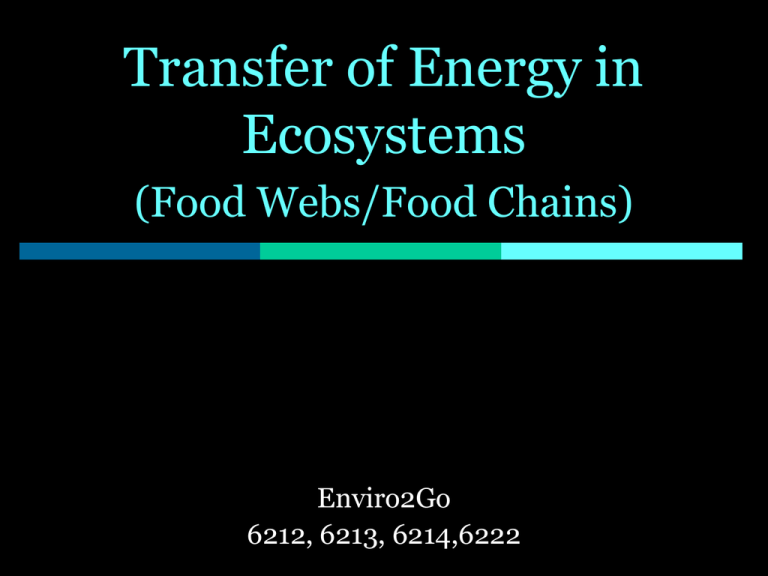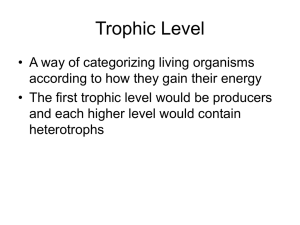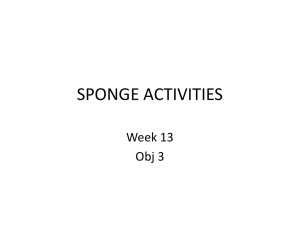Notes Energy Flow in Ecosystems
advertisement

Transfer of Energy in Ecosystems (Food Webs/Food Chains) Enviro2Go 6212, 6213, 6214,6222 Objectives: You will be able to: Explain how energy flows through an ecosystem in terms of trophic levels. Explain how trophic levels and food chains are related. Explain how the amount of energy changes as the trophic levels increase. Describe the role of each organism in a food chain or food web Describe similarities and differences between food chains and food webs. Describe and explain and organisms niche. Describe an energy & biomass pyramid. Key Vocabulary Trophic level Consumer Heterotroph Producer Autotroph Herbivore Omnivore Carnivore Scavenger Decomposer Food chain Food web Biomass pyramid Phytoplankton Zooplankton Krill Niche Energy pyramid The Sun The sun is the ultimate source of energy. The sun provides energy for photosynthesis, which allows plants to grow. Plants are important for a number of different reasons. Plants provide animals with the food and oxygen necessary for life. Niche Every organism has a niche. A niche is described as the organisms’ role in the ecosystem. The role is defined based on what it needs to survive; what it eats. Example: Squirrels are often called “acorn gatherers” because one of their main sources of food is acorns. This describes their niche. Producers Plants get their energy from the sun and use it to make glucose (sugar) during photosynthesis. Because plants make their own food (glucose) they are called producers. Another name for a producer is an autotroph. C0nsumers Since animals cannot make glucose they must eat other organisms to get energy. Any organism that eats to get energy is called a consumer. Another name for a consumer is a heterotroph. There are many different consumers. Consumers are titled based on what they eat. Types of Consumers Herbivores: only eat plants This deer is a herbivore because it eats plant material. Omnivores: eat plant & meat material This bear is a omnivore because it eats both plant and animal material. Carnivores: only eat meat This polar bear is a carnivore because it feeds of off other animals. More Types of Consumers Scavengers: eat off of dead organisms These vultures are feeding off of a dead elephant making them scavengers. Decomposers: break down dead or decaying material down old This fungi is an example of a decomposer because it is breaking plant material. The Importance of Decomposers Decomposers break dead things down so that they can be reused by plants and other organisms. If we did not have decomposers, ALL the things that have ever died since the beginning of time would still be lying around on Earth! REMEMBER THIS!!! Plants make their own food during photosynthesis. Plants use energy from the sun to make glucose (sugar). Therefore, plants are called producers. Animals eat plants to get energy because they cannot make their own food. Animals are called consumers. Consumers can be herbivores, omnivores, carnivores, or scavengers based on what they eat. Questions??? 1. What is the ultimate source of energy? 2. What is a niche? 3. An organism that makes its’ own food could be called a ___________, ___________ or ___________. 4. An organism that only eats meat is called a ___________. Food Chains A food chain shows the flow of energy from one organism to the next. As an organism eats another organism it receives energy. Therefore, consumers are found after producers in a food chain. The arrows in a food chain point in the direction that the energy is flowing. Food Chains In this marine (aquatic) food chain, the phytoplankton is the producer. That means the phytoplankton makes its’ own food during photosynthesis. The zooplankton is the herbivore because it eats the phytoplankton (the plant). The fish and whales are all carnivores because they eat only other animals (meat). Food Chains Consumers can also be classified as primary, secondary, tertiary or quaternary consumers. The zooplankton is the primary consumer because it is the first consumer. It eats the producer. The small fish are the secondary consumers because they eat the primary consumer. The large fish is the tertiary consumer because it eats the secondary consumer. The whale is the quaternary consumer because it eats the tertiary consumer. REMEMBER THIS!!! Food chains show the flow of energy in an ecosystem. Organisms eat other organisms to get energy. The arrows in a food chain show the direction that the energy is moving. Questions??? 5. What is/are the producer(s) in this terrestrial food chain? 6. What is/are the herbivore(s) in this terrestrial food chain? 7. What is/are the carnivore(s) in this terrestrial food chain? Create Your Own Food Chain Visit the following website to create your own food chain! Make Your Own Food Chain! Food Webs Food webs are multiple food chains all interconnected. Food webs show most of the possible foods an organism can eat in that ecosystem. Food webs can be terrestrial (land based) or aquatic (water based). Terrestrial Food Web The vegetation is the producer in this food web. The insects, mice, rabbits and deer are all herbivores. They are also considered primary consumers. The snake, frogs, foxes, and cougar are all carnivores. They are also considered secondary consumers. The fox can also be considered a tertiary consumer when they eat the frog. This is because the frog is a secondary consumer, & the insect is the primary consumer. Questions??? 8. What is the producer in this terrestrial food web? 9. What is/are the primary consumer(s) in this food web? 11. Are there any omnivores in this food web? If so, what are they? 10. Would the owl be a herbivore, omnivore or carnivore? Aquatic Food Webs Ocean food webs begin with phytoplankton. Phytoplankton are small aquatic plants found near the ocean’s surface. Phytoplankton is eaten by zooplankton; tiny animals. Krill is a common example of zooplankton. Krill are tiny shrimp-like creatures that eat both phytoplankton and zooplankton. Watch This Video on Krill! - Krill Changes in Food Webs When the population of one organism in a food web changes, all other organisms can be affected. For example in this food web, if the population of the zooplankton decreased: The phytoplankton would increase because nothing would be eating it. The migrating midwater fishes would decrease because they would have no food. This would result in competition and a decrease in the other fish due to a lack of food. - Krill Changes in Food Webs Use this link to see the affects of changing populations within an ecosystem. Changes in Food Webs! Questions??? Using the information from the video you just watched, answer the following questions. What would happen to the Great Blue Heron population if the algae decreased? What would happen to the perch if the bass population increased? Energy Pyramids An energy pyramid shows the energy flow from one organism to the next. Each level in an energy pyramid is called a trophic level. coyote fox rabbit grass This level contains carnivores. Trophic Level 4 Trophic Level 3 This level contains omnivores or carnivores. Trophic Level 2 Trophic Level 1 This level always contains producers. This level contains herbivores and omnivores. Energy Pyramids As energy moves from one trophic level to the next, energy is lost. This is because organisms use energy to live, so only a little bit of energy goes to the animal that eats it. Only 10% of the energy is passed on from one trophic level to the next. That means organisms use 90% of the energy they make/consume for their own activity. Energy Pyramid coyotes fox rabbit grass Trophic Level 4 1 unit of energy Trophic Level 3 10 units of energy Trophic Level 2 Trophic Level 1 100 units of energy 1000 units of energy In this energy pyramid the grass has 1000 units of energy. It will use 90% of the energy and pass 10% on to the rabbit. This continues through the food chain. Since the energy decreases, the amount of animals high up on the food chain also decrease because they have to eat more to get enough energy to live. Therefore, there will always be more producers than consumers. REMEMBER THIS!!! As trophic levels increase, the amount of energy they receive decreases. Questions??? 14. Each level of an energy pyramid is called a _______ _______. 15. Would you find a producer or consumer at the first trophic level? 16. Where is the most available energy, trophic level 1 or trophic level 4? Why? 17. What percent of energy moves from one organism to the next? Biomass Pyramids Biomass is the dry weight of plants and animals. Because energy decreases from one trophic level, there are less animals at high trophic levels of a food chain. So, only about 10% of the total biomass moves on from one trophic level to the next. Review Visit the following website to review food chains, food webs, energy pyramids and biomass pyramids! Quick Review! Summary Food chains show the flow of energy from one organism to another. A food web shows the multiple feeding relationships that can occur. Organisms eat other organisms to get energy. However only 10% of the energy gets passed on. An energy pyramid shows the loss of energy from one trophic level to the next. Remember, only 10% of the energy moves from one level to the next! Test Yourself: True or False ____ 1. Producers are animals. ____ 2. A carnivore eats only plants. ____ 3. Zooplankton is food for larger fish. ____ 4. Decomposers are a special kind of consumer. ____ 5. The sun is the ultimate source of energy for ecosystems. ____ 6. A niche is where an organism lives. ____ 7. A niche tells us what an organism eats and sleeps, among other things. Test Yourself: Matching ____ 1. trophic level a) The dry weight of organisms in a food chain ____ 2. energy pyramid b) Eats only producers ____ 3. producer c) Breaks down dead, decaying matter ____ 4. consumer d) Eats only consumers ____ 5. herbivore e) Makes their own food from the sun ____ 6. omnivore f) Eats dead organisms ____ 7. carnivore g) Eats both producers and consumers ____ 8. scavenger h) Feeding levels in a food chain ____ 9. decomposer i) Must obtain energy by eating other organisms ____ 10. biomass j) Diagram that shows the amount of energy transferred between organisms Test Yourself : Fill in the Blank decomposers trophic 1. that food chain herbivores food web energy The term ____________________ is given to the bacteria break down dead tissue. 2. In an ecosystem, ____________________ decreases at each higher trophic level. 3. Animals known as ____________________ eat only primary producers. 4. A path of energy through the trophic levels of an ecosystem is called a(n) ____________________ ____________________. 5. The interrelated food chains in an ecosystem are called a(n) ____________________ ____________________. Test Yourself: Short Answer 1. The grocery store has a section in it called the Produce section. What types of things do you find in that section? 2. In a food chain, where are the producers always found? 3. Why are consumers always listed after producers in a food chain? Test Yourself: Short Answer 4. What is the difference between a food chain and a food web? 5. Why are decomposers necessary for the continuation of life on Earth?






